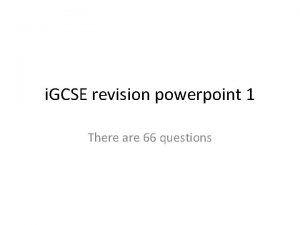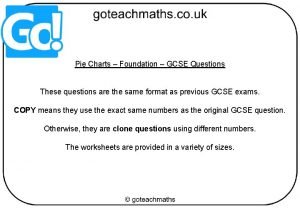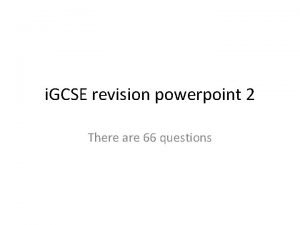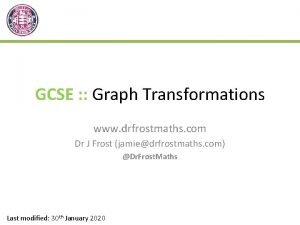Top 10 maths topics that GCSE students struggle




















- Slides: 20

Top 10 maths topics that GCSE students struggle with

2 Contents 1. Lowest common multiples and highest common factors 2. Expand simplify equations in brackets 3. Converting decimals to fractions 4. Finding nth terms 5. Solving quadratic equations 6. Rearranging equations to find the subject 7. Prime factorisation 8. Intersections of a curve 9. Fractional indices (high level topic) 10. Rationalising denominators (high level topic)

3 1. Lowest common multiples and highest common factors Example question: What is the difference between LCM and HCF? Answer and explanation: LCM stands for Lowest Common Multiple, and HCF stands for Highest Common Factor. The key to telling the difference between these two things is knowing the difference between a multiple and a factor. A multiple of an integer (whole number) is any integer that appears in its times table. For example, the multiples of 3 are 3, 6, 9, 12, and so on. A factor of an integer is any integer that divides the integer with no remainder. For example, the factors of 36 are 1, 2, 3, 4, 6, 9, 12, 18, and 36. We use LCM and HCF to compare two (or more) integers. The LCM of two integers is the smallest whole number that appears in both of their times tables, that is, the smallest integer that is a multiple of both numbers. For example, the LCM of 4 and 5 is 20. To see this, look at the multiples (times table) of 4: 4, 8, 12, 16, 20, 24, 28, … Top tip As there are different methods to approach these questions, students need to fully understand the purpose of each step before they begin to tackle the question and of 5: This question is continued on the next slide

4 1. Lowest common multiples and highest common factors 5, 10, 15, 20, 25, … The LCM is 20 because this is the first number that appears in both lists. The HCF of two integers is the largest whole number that divides both numbers without leaving a remainder. For example, the HCF of 16 and 24 is 8. Again, we can look at both sets of factors and compare. The factors of 16 are: 1, 2, 4, 8, 16 And the factors of 24 are: 1, 2, 3, 4, 6, 8, 12, 24. Although 2 and 4 are common factors (that is, they appear in both lists), we are looking for the highest common factor. The answer is 8. Top tip As there are different methods to approach these questions, students need to fully understand the purpose of each step before they begin to tackle the question

5 2. Expand simplify equations in brackets Example question: Expand simplify 3(2 x + 5) – 2(x – 4) Answer and explanation: Firstly, to expand an equation like this, you must multiply the brackets by the number outside of the brackets. Make sure that you multiply every number inside the bracket by the number directly outside, and remember the signs: 3(2 x + 5) - 2(x-4) becomes (3 * 2 x) + (3 * 5) + (-2 * x) + (-2 * -4) = 6 x + 15 - 2 x + 8 (remember that '-' * '-' = '+') Then you need to do something called 'collecting the like terms'. This means collecting together all the 'x' terms and all of the 'number' terms, like this: 6 x + 15 - 2 x + 8 becomes (6 x - 2 x) + (15 + 8), working this out means: The answer is: 4 x + 23. Top tip Don’t forget the rules of ‘signs’ when multiplying the number outside the bracket with each term inside the bracket. E. g 2 X (4 -3 x)= (-2 x*4) + (-2 x*-3 x).

6 3. Converting decimals to fractions Example question: How would you convert the decimal 0. 125 into a fraction in its simplest form? Answer and explanation: 0. 125 is the same as 125/1000. We have to remove the decimal point before creating a fraction. 0. 125 multiplied by 1000 is 125 and at this point the decimal point has been removed, so 0. 125 is equal to 125/1000. But 125/1000 is not the simplest form that the fraction could be in. If we divide both the top and the bottom by 5 since we know 125 is a multiple of 5, we get 25/200. Divide both by 5 again to get 5/40. Divide by 5 one more time to get 1/8, and since the numerator is 1, the fraction cannot be simplified any further. Therefore, the answer in its simplest form is 1/8.

7 4. Finding nth terms Example question: How do you find the nth term formula for a sequence with non-constant difference? Answer and explanation: Take the sequence; 9, 12, 19, 30, … (1) The first step is always to look at difference between the terms; 9, 12, +3, 19, +7, +4, 30, … +11, … +4, … We can see the difference is not constant, (2) so we looked at the change in the difference each term. This gives a constant change in the difference of an extra +4 each term. The fact that we needed to take 2 turns to find the constant difference means we are dealing with a quadratic sequence. (3) Furthermore, because the difference is +4, we are dealing with a 2 n 2 sequence. Top tip It’s easy to forget the different methods for linear sequences and quadratic sequences. As it’s a quadratic sequence it needs extra steps! If the change in the difference is (a) then the nth term follows a (1/2 a)n 2 pattern. (4) Now we can rewrite the sequence as follows; This question is continued on the next slide

8 4. Finding nth terms 9 12 19 30 n 1 2 3 4 n 2 1 4 9 16 2 n 2 2 8 18 32 (5) We need to find the difference between the sequence and 2 n 2. 9 12 19 30 2 n 2 2 8 18 32 d -7 -4 -1 +2 (6) The difference here will either be a constant number, in which case the nth term is (1/2 a)n 2 +d. Or like this case, will itself follow a linear sequence with constant difference, which we should know how to solve. 1 -7, +3 Top tip It’s easy to forget the different methods for linear sequences and quadratic sequences. As it’s a quadratic sequence it needs extra steps! 2 -4, +3 3 -1, +3 4 +2 This gives 3 n - 10. Therefore, the whole formula for the nth term is; (7) 2 n 2 + 3 n - 10

9 5. Solving S quadratic equations Example question: Solve the quadratic equation x^2 + 4 x +1 = 0 by completing the square. Answer and explanation: Completing the square means to put our equation into a slightly different form which looks like this, where a and b are real numbers: (x+a)2 + b = 0 From here, we can rearrange the equation and directly solve for x. Let's have a look at our specific example: x 2 +4 x +1 = 0 The first step is to divide the coefficient of x by 2, and add this to x (this is our value of 'a' to go inside our bracket). We then square this value of a and subtract it outside the bracket. In our example it will look like this: (x+2)2 - 4 + 1 = 0 (x+2)2 - 3 = 0 This question is continued on the next slide

10 5. Solving S quadratic equations We have our equation in completed square form. [There is a quick way to check we've got this right by expanding out this equation quickly: (x+2) - 3 = 0 x 2 + 4 x + 4 - 3 = 0 x 2 + 4 x +1 = 0 We're back to our original equation, so we know we've got it right. Let's go and solve our equation in completed square form. ] We simply rearrange for x: (x+2)2 - 3 = 0 Add 3 to both sides. (x+2)2 = 3 Take the square root of both sides. This splits into two possible cases: Case 1: Positive square root of 3 This question is continued on the next slide

11 5. Solving S quadratic equations x+2 = + √ 3 x = - 2 + √ 3 Case 2: Negative square root of 3 x+2 = - √ 3 x = - 2 - √ 3 So our final answer is. . . x = - 2 + √ 3 x = - 2 - √ 3

12 6. Rearranging equations to find the subject Example question: How do you change the subject of the formula? Answer and explanation: All that changing the subject of the formula means is basically getting a letter on its own on one side of the equation. To begin, let's take a relatively simple example. Make x the subject of the formula: 4 y + 2 = x - 4 What this question basically means is get x on its own. At the moment on the right-hand side we have x - 4. So, because we want x on its own what we can do is add 4 to this side. However, we must then add 4 to the left-hand side to balance the equation (remember what we do to one side when changing the subject of the formula WE MUST DO TO THE OTHER SIDE). This then gives us the following: 4 y + 2 + 4 = x Top tip Don’t forget to reverse the processes when questions involve fractions and indices! This question is continued on the next slide

13 6. Rearranging equations to find the subject So, our final answer is: x = 4 y + 6 We have successfully made x the subject of the formula. Now let's try something a little bit more challenging: Make y the subject of the formula. 2 y/5 - 3 x = 2 First, we must isolate the 2 y/5. To do this we can add 3 x to both sides to get rid of it on the left side and get 2 y/5 on its own. This gives us: 2 y/5 = 2 + 3 x Now, the 2 y is divided by 5, therefore by doing the inverse function of division which is multiplication, we can get 2 y on its own. So, we can multiply both sides by 5. 2 y/5 * 5 = 5 * (2 + 3 x) 2 y = 5(2 + 3 x) Top tip Don’t forget to reverse the processes when questions involve fractions and indices! This question is continued on the next slide

14 6. Rearranging equations to find the subject It's probably easier if these brackets are expanded so: 2 y = 10 + 15 x Finally, we must get y on its own. At the moment the y is being multiplied by 2. So, we must do the inverse function and divide 2 y by 2. Remember to divide by 2 on both sides. 2 y / 2 = (10 + 15 x) / 2 y = (10 + 15 x) / 2 This can be simplified to: y = 5 + 15 x/2 This is because 10/2 = 5 and 15 x 2 =is just 15 x/2. We have now successfully made y the subject of the formula. The key things to remember when changing the subject of the formula are: All it means is get a letter on one side of the equation on its own: Use inverses functions (+ and - are inverses of each other and so are * and /) to isolate the letter Top tip Remember to put brackets around 2 + 3 x because both the 2 and the 3 x are being multiplied by 5. Whatever you do to one side you must do to the other.

15 7. Prime P factorisation Example question: Express 300 as a product of its prime factors Answer and explanation: Factors of a number are: numbers that can be multiplied (by a whole number/ integer) to make the original number. For example, 6 is a factor of 42, because 6 can be multiplied by 7 to make 42. Prime numbers are numbers that cannot be divided by anything except themselves and 1 to give a whole number answer; for example 3 and 11. Each time you find a prime factor, circle it in your working, so you do not end up missing one out in your final answer - in this example I underline each prime factor I find. In order to split 300 into its prime factors, first of all think of a number than goes into 300: ● Let us start with 30. 30 goes into 300 at total of 10 times, as 30 x 10=300. ● So, we now have two factors of 300: 30 and 10. Now, we must find the factors of these two numbers: ○ Factors of 10: 5 x 2 = 10. As the numbers 5 and 2 are both prime numbers, they are counted as prime factors for 300. ● Factors of 30: 3 x 10 = 30. As 3 is a prime number, we have found another prime factor of 300. Top tip The tree/branch method is ideal to find all the prime factors of an integer. Once understood and mastered, this tree can be used for LCM and HCF questions also. This question is continued on the next slide

16 7. Prime P factorisation However, 10 is not a prime factor, and so we must keep going: 5 x 2 = 10, and therefore we have found another two prime factors: 5 and 2. Looking back over your working, write down every number that is circled (or in this case, underlined): 5, 2, 3, 5, 2 So, we can write 300 as a product (multiplication) of its prime factors by multiplying them all: 2 x 3 x 5 This can be rewritten as 22 x 3 x 52 Top tip The tree/branch method is ideal to find all the prime factors of an integer. Once understood and mastered, this tree can be used for LCM and HCF questions also.

17 8. Intersections of a line and a curve Example question: How do I find the intersection of a line and a curve? Answer and explanation: Say you are given the equations of both a line and a curve, for example y=x 2+8 x-1 and y=3 x-7, and asked to find where these two intersect. This just means where the two lines would cross or touch if drawn on the same graph. To find these points you simply have to equate the equations of the two lines, where they equal each other must be the points of intersection. For this example this would mean x 2+8 x-1=3 x-7 Collecting like terms leads to x 2+5 x+6=0 And from then this is a simple case of solving the quadratic. This expression factorises to (x+2)(x+3)=0 which implies either x=-2 or x=-3. To find the corresponding y coordinates for each point simply input these x values one at a time into either one of the original equations. For x=-2, we get y=3(-2)-7=-13 so the point is (-2, -13) Top tip For x=-3, we get y=3(-3)-7=-16 so the point is (-3, -16) Remember the difference between linear and quadratic equations! Both of these are valid intersection points for the line and curve given.

18 9. Fractional indices (High level topic) Example question: How do you calculate a number to the power of a fraction? (8^2/3) Answer and explanation: When a number is raised to the power of a fraction, it is the same as rooting that number to the denominator (the number on the bottom). So if the number is raised to ½ it is the same as √ and if it is raised to ⅓ it is the same as ³√. The situation becomes more complicated when the number is raised to another power such as 2/3 but there is a simple solution to working out this problem. If we take the example 8^2/3 we can make it much easier to solve by changing the power to 1/3 by putting the whole thing in brackets with the 2 outside giving us (8^1/3)^2. We can start off by solving what is inside the brackets which is 8^1/3. Top tip These are the more difficult questions in the GCSE exams and students often confuse whether one roots the number by the numerator or the denominator- a technique would be to reassure them that the numbers would be simple, an integer and easy to work with, especially in noncalculator papers. So, if they need to root 4 by 3, they are most likely to be using the numbers the wrong way around. We already know that when something is to the power of ⅓ it is the same as cube root so ³√ 8 = 2. This leaves us with 2^2 to solve which is 4. Therefore 8^2/3 = 4

19 10. Rationalising denominators (High level topic) Example question: Rationalising the denominators (Surds) Answer and explanation: When asked to rationalise simple Surd (square roots that cannot be reduced to a whole number) fractions in the form a/√b we are aiming to remove the surd in the denominator (bottom). e. g 1. Rationalise 3/√ 2 Answer: We multiply the entire fraction by the denominator √ 2/√ 2 (this is equivalent to 1). Let us first consider what happens to the denominator: √ 2 x √ 2 = 2 (any simple surd multiplied by itself equals the number inside) The numerator (top) becomes 3 x √ 2 or 3√ 2 So the fraction rationalises to 3√ 2 / 2, the surd has now been removed from the denominator. Typically you will be asked to simplify the fraction which is just asking you to rationalise it. Top tip Practice makes perfect! These higherlevel questions can be tough, but with enough practice of the methodology students will learn exactly what to do. The rationalised fraction can be used more easily in further calculations.

20 Interested in a one-to-one tuition programme for your school? Here’s how it works - You identify students who would benefit most from one-to-one support - We then match each of your students with a dedicated tutor and set-up your school portal - Once set up, our tutors deliver targeted online lessons, keeping you closely updated with your students’ progress We’d love to hear about your goals and discuss how My. Tutor can support them. Call us for a chat on 02037736025 or email richard@mytutor. co. uk.
 Ngoại tâm thu thất chùm đôi
Ngoại tâm thu thất chùm đôi Chiến lược kinh doanh quốc tế của walmart
Chiến lược kinh doanh quốc tế của walmart Gây tê cơ vuông thắt lưng
Gây tê cơ vuông thắt lưng Block av độ 1
Block av độ 1 Tìm vết của đường thẳng
Tìm vết của đường thẳng Sau thất bại ở hồ điển triệt
Sau thất bại ở hồ điển triệt Thể thơ truyền thống
Thể thơ truyền thống Con hãy đưa tay khi thấy người vấp ngã
Con hãy đưa tay khi thấy người vấp ngã Thơ thất ngôn tứ tuyệt đường luật
Thơ thất ngôn tứ tuyệt đường luật Tôn thất thuyết là ai
Tôn thất thuyết là ai Power point presentation topic in hindi
Power point presentation topic in hindi Prerequisites for health education
Prerequisites for health education Short article for school magazine in english
Short article for school magazine in english What is this
What is this Gcse cambridge maths
Gcse cambridge maths Pie chart gcse questions and answers
Pie chart gcse questions and answers Anticipating misuse computer science
Anticipating misuse computer science Bedfordshire childcare courses
Bedfordshire childcare courses Revision techniques gcse powerpoint
Revision techniques gcse powerpoint Transformations dr frost
Transformations dr frost Maths gcse grade boundaries
Maths gcse grade boundaries







































